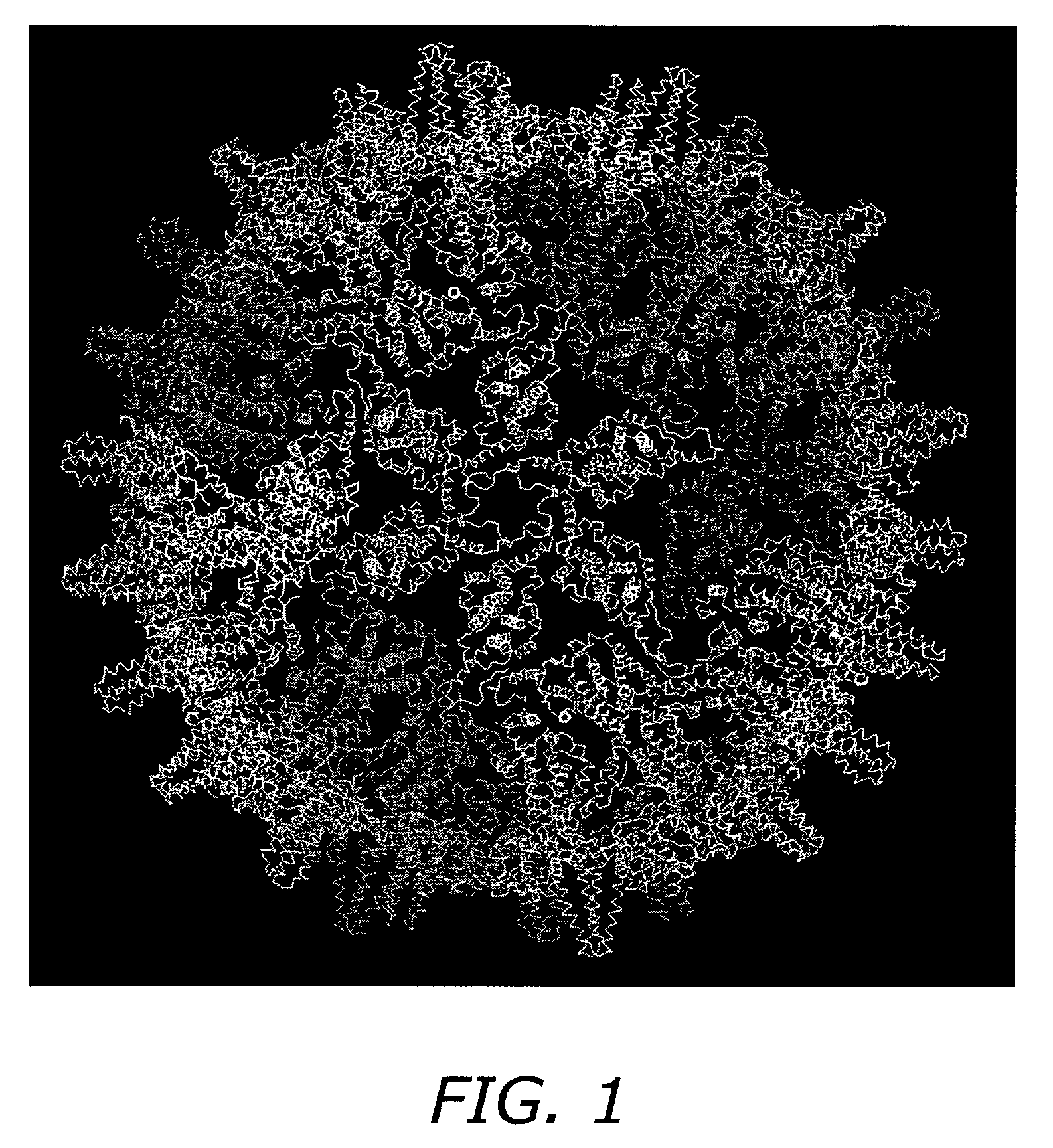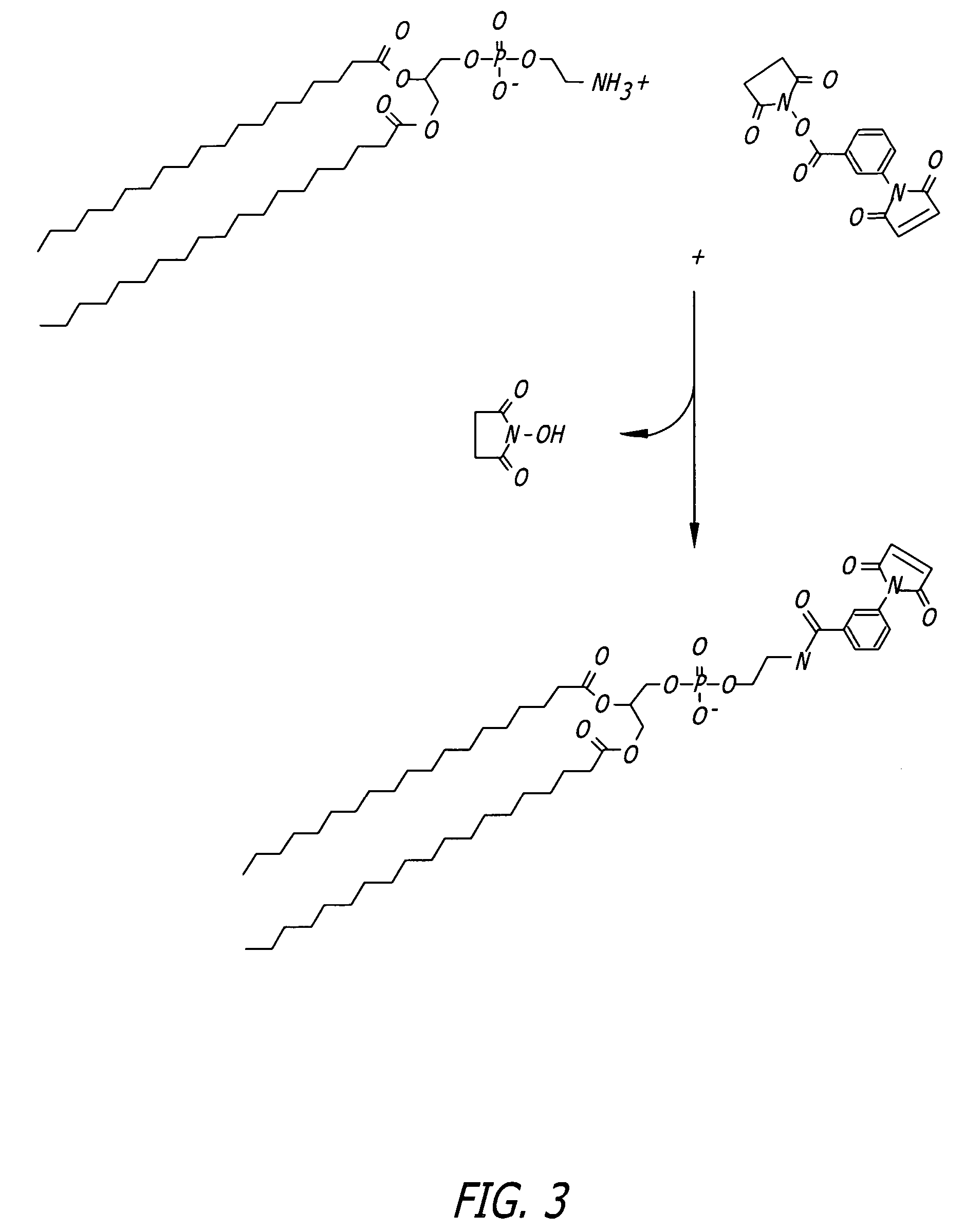Self-assembling nanoparticle drug delivery system
a drug delivery system and nanoparticle technology, applied in the field of self-assembling drug delivery systems, can solve problems such as system non-replicability, and achieve the effect of facilitating membrane transduction
- Summary
- Abstract
- Description
- Claims
- Application Information
AI Technical Summary
Benefits of technology
Problems solved by technology
Method used
Image
Examples
example 1
Core Protein Expression and Purification
[0089]A pET-11a vector containing the full-length HBV C-protein gene, is transformed into E. coli DE3 cells and grown at 37° C. in LB media, fortified with 2-4% glucose, trace elements and 200 ug / mL carbenicillin. Protein expression is induced by the addition of 2 mM IPTG (isopropyl-beta-D-thiogalactopyranoside). Cells are harvested by pelleting after three hours of induction. SDS-PAGE is used to assess expression of C-protein.
[0090]Core protein is purified from E. coli by resuspending in a solution of 50 mM Tris-HCl, pH 7.4, 1 mM EDTA, 5 mM DTT, 1 mM AEBSF, 0.1 mg / mL DNase1 and 0.1 mg / mL RNase. Cells are then lysed by passage through a French pressure cell. The suspension is centrifuged at 26000×G for one hour. The pellet is discarded and solid sucrose added to the supernatant to a final concentration of 0.15 M and centrifuged at 10000×G for one hour. The pellet is discarded and solid (NH4)2SO4 is then added to a final concentration of 40% sa...
example 2
Protocol for Phospholipid Conjugation via SMPB Intermediate (FIG. 2)
[0091]1. Dissolve 100 micromoles of phosphatidyl ethanolamine (PE) in 5 mL of argon-purged, anhydrous methanol containing 100 micromoles of triethylamine (TEA). Maintain the solution under an argon or nitrogen atmosphere. The reaction may also be done in dry chloroform.
[0092]2. Add 50 mg of SMPB (succinimidyl-4-(p-maleimidophenyl)butyrate, Pierce) to the PE solution. Mix well to dissolve.
[0093]3. React for 2 hours at room temperature, while maintaining the solution under an argon or nitrogen atmosphere.
[0094]4. Remove the methanol from the reaction solution by rotary evaporation and redissolve the solids in chloroform (5 mL).
[0095]5. Extract the water-soluble reaction by-products from the chloroform with an equal volume of 1% NaCl. Extract twice.
[0096]6. Purify the MPB-PE derivative by chromatography on a column of silicic acid (Martin F J et al., Immunospecific targeting of liposomes to cells: A novel and efficient...
example 3
Protocol for Phospholipid Conjugation via MBS Intermediate (FIG. 3)
[0098]1. Dissolve 40 mg of PE in a mixture of 16 mL dry chloroform and 2 mL dry methanol containing 20 mg triethylamine, maintain under nitrogen.
[0099]2. Add 20 mg of m-maleimidobenzoyl-N-hydroxysuccinimide ester (MBS) to the lipid solution and mix to dissolve.
[0100]3. React for 24 hours at room temperature under nitrogen.
[0101]4. Wash the organic phase three times with PBS, pH 7.3, to extract excess cross-linker and reaction by-products.
[0102]5. Remove the organic solvents by rotary evaporation under vacuum.
PUM
| Property | Measurement | Unit |
|---|---|---|
| size | aaaaa | aaaaa |
| diameter | aaaaa | aaaaa |
| ionic strength | aaaaa | aaaaa |
Abstract
Description
Claims
Application Information
 Login to View More
Login to View More - R&D
- Intellectual Property
- Life Sciences
- Materials
- Tech Scout
- Unparalleled Data Quality
- Higher Quality Content
- 60% Fewer Hallucinations
Browse by: Latest US Patents, China's latest patents, Technical Efficacy Thesaurus, Application Domain, Technology Topic, Popular Technical Reports.
© 2025 PatSnap. All rights reserved.Legal|Privacy policy|Modern Slavery Act Transparency Statement|Sitemap|About US| Contact US: help@patsnap.com



